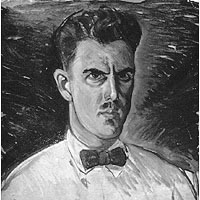Success Starts Here
Your gateway to the Library Catalog, Digital Items, Library Website search results, and more simultaneously!
Your gateway to the Library Catalog, Digital Items, Library Website search results, and more simultaneously!


Ranch Kimball was born in Salt Lake City in 1894. He was a regionalist painter who became and businessman and arts patron. He died in Salt Lake City.
Kimball studied under E. H. Eastmond and B. F. Larsen from 1912 to 1913 at Brigham Young University. He studied at the Art Institute of Chicago from 1915 to 1918. Boardman Robinson was an instructor at the Art Students League in New York where Kimball studied in 1916.
Returning to Utah in 1920, Kimball exhibited his work at the Utah State Fair. Through the 1920s and early 1930s he traveled in Utah, painting mostly landscapes. Some of his notable paintings are Zion Entrance, Touch of Modern, and Trees.
Biography adapted from Springville Museum of Art.
Ranch Kimball was born in Salt Lake City in 1894. In high school he studied mechanical drawing, and then he studied art at Brigham Young University from 1912-1913. After his two years at B.Y.U., where he worked under E. H. Eastmond and B. F. Larsen, he went on to spend three years at the Art Institute of Chicago. While at Chicago, Ranch studied lettering from Oswald Cooper. Cooper predicted that Kimball would one day develop his own script, the sans serif, he preferred. And, as seen in his signature and later in his signs for Lagoon, he did go on to develop a personal script without a serif.
At age 22, Ranch Kimball moved to New York to study at the Art Student's League with Boardman Robinson, whom he had long admired. After working as an artist both in Chicago and New York City, Kimball went back to Utah and regularly exhibited his paintings at the Utah State Fair between 1920 and 1930. In addition to painting, he began drawing pastels of scenes in and around Salt Lake City. One biographer describes his work as:
. . “. filled with fantasy shapes and colors, distances of round rolling hills, old smooth cliffs, walls of a house that couldn't possibly hold up the queerly shaped roof. The colors he chose are bright, strange, and lively. A purple road, “Kimball“ pink cliffs, and beautiful shades of green. “
In 1934, he worked for the P.W.A.P. (Public Works of Art Project) in Utah, a federally funded project that gave work to artists during the Depression. Ranch was assigned to make “sketches of activities of various governmental branches.“ During this time he painted Entrance to Zion. This painting shows a Civilian Conservation Camp (C.C.C.) check station at the main entrance to Zion National Park. The painting was modern for its day. The pigment is thin and flat, and the grandeur of Zion's is not lost in a painterly study of color or light. He focuses on the architectonic qualities of the scene by using a flat brush stroke and by stressing the formal lines and shapes of the monumental rock formations.
Kimball's work was much influenced by the regional movement in art during the 1930s. Like others, he painted scenes he knew well, the city and countryside of Utah, but with an inimitable style of his own. However, in 1934, Ranch left art for other interests, including the Kimball Sign Company which he had started as a teenager. His contribution to the Utah art scene did not end with his switch in focus, as he continued to collect works of various artists of the Intermountain West. In addition, from 1940 to 1944, Kimball was a member of the board of the Utah State Institute of Fine Arts.
Not long after World War II, Ranch began work with the Lagoon Amusement Park, just north of Salt Lake City. The park suited his temperament. “It's a beautiful day at Lagoon,“ he enthusiastically greeted telephone callers. In 1953, when the older buildings were burned in a fire, Ranch supervised the building of the new Lagoon, bathing the structures in the whimsical colors he loved. He painted the merry-go-round himself, creating a turquoise lion with a purple mane as well as several Mother Goose characters.
Later Ranch Kimball became the president and general manager of both the “State Amusement“ and “Lagoon“ corporations, and vice president of “Amusement Service“ in Salt Lake City. When he sold his business interests and retired, he sometimes considered taking up painting again, but he never did. Ranch Kimball was a vivacious man who “. . . worked as cartoonist, sign painter, graphic artist, illustrator, actor, magician, and businessman. He was “. . . a man too spirited to limit himself to a single pursuit.“
Biography courtesy Springville Museum of Art.
Books
Breckinridge, M. First National Exhibition of American Art: May 18th to July 1st 1936. New York, NY: Municipal Art Committee, 1936.
Dawdy, Doris. Artists of the American West: A Biographical Dictionary. Chicago, IL: Sage Books, 1990.
Dunbier, Roger. North American Artists: The Artists Bluebook. Scottsdale, AZ: AskART.com, 2000.
Haseltine, James L. 100 Years of Utah Painting: Selected works from the 1840s to the 1940s. Salt Lake City, UT: Salt Lake Arts Center, 1965.
Olpin, Robert, S., William C. Seifrit and Vern G. Swanson. Artists of Utah. Salt Lake City, UT: Gibbs Smith Publisher, 1999.
Reinhardt, Lisa. Davenport's Art Reference & Price Guide 2001/2002. Phoenix, AZ: Gordon's Art Reference, 2000.
Swanson, Vern G., Robert S. Olpin, Donna Poulton, and Janie Rogers. 150 Year Survey Utah Art, Utah Artists. Layton, UT: Gibbs Smith Publisher, 2001.
Swanson, Vern G., Robert S. Olpin, and William C. Seifrit. Utah Art. Layton, UT: Peregrine Smith Books, 1991.
Swanson, Vern G., Robert S. Olpin, and William C. Seifrit. Utah Painting and Sculpture, Layton, UT: Gibbs Smith Publisher, 1991.